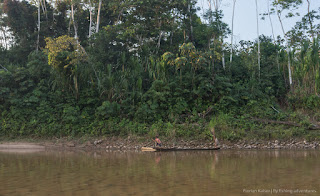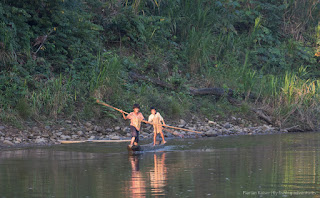For the next day,
Chris and I had high anticipation. The plan was to tramp to a headwater camp of
a tributary of Secure. A backcountry trip with in the Bolivian backcountry only
for the experienced and angler used to walk many hours a day without a patch. Marcelo,
one of the shareholder and founders of Untamed proposed that to me one year
before the trip, while I met him after my exploratory trip to Kendjam in August
2015. His words made me listen.
The following night that
annoying bird with its stupid night call was not the worst. Instead the super
worst thing happened: in the middle of the night a thunderstorm with very heavy
rain reached the whole catchment. Heavy rain was pouring down, lightning
strikes right at the camp and close by several times. As if the river would
flow directly down right from the sky. Lots of water, too much water for my
taste.

In the morning everything was wet, Secure was up and dirty with big tress and logs floating down. How much rain came down, where and with which effect on the tributary we wanted to fish? Questions, doubt and hope at the same time. Finally Luciano came with the bad news that our tributary was flowing roaring four meters above normal level and two of four Tsimane canoes where swept away. No chance to go there this day. The other two groups tried to fish the main river but came back after less than an hour as the main river still rose considerably. We were disappointed. Our plans we dreamed of did not work out. The rain stopped early morning but Secure continued to rise till around 7pm the same day, thus around 12-13 hours later. The whole catchment got a solid storm. Our only option was to wait till the next morning. We did that, spending the day by reading, chatting, writing, sleeping and eating and possibly smoking. Sometimes a day of rest is not the worst, but with those great plans in mind it was just a nuisance, kind of like a wind knot in the leader.
This situation clearly
showed that fishing-plans are related to weather and sometimes it is just luck
to hit the conditions just right. In locations like that or for example SI NZ, be
aware that you might lose the one or other day during a week due to high water.
Don’t be upset, enjoy the other days even more!
Next morning we were very
happy: we could start our tramp upriver. The tributary was still high and murky
like a too strong coffee with some milk and mixed in sand. Neither good for
fishing nor for drinking. Crossing the river, back and force at top of the
pools, walking on the side or in the river up to the chest, swimming twice with
the watertight Patagonia floating backpack as a micro raft for the rod. I did
not check the time but guessing we were around 3 to 4,5 hours on our feed.
After a while we started to make a few casts in highly promising water or when
we could identify some likely Dorado action. Not much success though.
As we came closer to
the spot that was supposed to be our camp for the night, the expectations rose,
if the camp would still be there or would have been washed away with the trees
and trunks we saw floating down the river. Guide Luciano accelerated his step.
Not looking back once (as he never did in my impression - strange habit when
you fish with clients).
Some two kilometers
below the camp spot we found the shell of one tent stuck in some driftwood. Luckily
this was the tent that had the lowest location within the camp, so there was
still hope.
Approaching the camp the water was supposed to become clearer. It
did that but only with a gradient as if you would slowly drip single drops of
clear water in the above mentioned strong milk coffee.
The tributary up here
normally would run close to gin clear, but this day it did not. It was still
high and dirty. We finally reached the camp and were surprised to see the two
sleeping tents still in place. They got some water inside and might have been
under water for up to a foot during peak flood, but it meant that our plan to
camp and fish the other day was not jeopardized. As the four Tsimane following
us some hours later would bring Chris’ and mine dry sleeping bag, we even would
not have to rest like a fish in a wet environment but would have a dry place to
sleep. So this adventure could continue and we did not yet start fishing
seriously.
A tremendous part of
fly fishing and traveling – at least for me - is to experience truly remote
place, discover untouched nature and to see places “normal” tourists barely ever
might visit. After years of traveling that became kind of normal to me. But this
place nevertheless was special, remote jungle within an area that was already remote. Birds,
butterflies, fish, trees, plants and the river. But as remote places with
frequently awesome nature are linked to the style of fly fishing I love, I am kind of
used to it and do not consider it as unusual. I just soak it up in my memory and silently enjoy.
At that place I would not have been surprised if there would have been a Jaguar
right behind the next river bend as we were in an area with one of the highest
remaining Jaguar populations on that planet.
We had very high
anticipations for the remaining hours of the day…
(spoiler: some very good action was just hours away!)
(spoiler: some very good action was just hours away!)
If you like what you read - share it! : )






































































